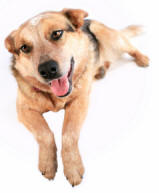 DOWN
means, "Belly
and elbows all the way to the
ground."
DOWN
means, "Belly
and elbows all the way to the
ground."
We will tell you about
our preferred methods
but we will also tell
you about methods we
prefer NOT to use
because
you may see or
they may be
recommended
to you by someone else. Please
avoid these methods
which use force and
pressure and if our
recommended method does
not work for you send us
an email so we can help
fine tune the process
for you!
These
"NOT our Choice
methods" do not
physically harm
the pet but they
are not the
best training methods
because they are forcing
the pet to do something
it was not willing to do
on their own. It is not
allowing the dog to
figure out what you are
requesting on their own
terms. When the pet is
allowed to figure out
through trial and error
what you want it leads
to higher success with
each additional command
you wish to teach. The
methods which rely on
physical touching also
lead to a pet that
waits for you to touch
them
before they preform the
command which is rarely
convenient for anyone.
Our Method
1. Start with the
dog sitting. If the "sit"
on cue is not known,
teach that first.
2. Give
one treat for a successful
"sit." This shows the dog
that you control the treats.
3. Move
the food lure slowly - straight
down and back between the dogs front two feet. Move food lure slowly back under the dog's
chest.
4.
Initially,
give a lick of the the treat for any movement
toward lying down. (e.g.
ducking the head) Giving
tastes of the treat and small pieces will keep
the dog's interest.
5. Don't
add the verbal Instruction,
"down" until
you are sure the dog is
about to lie down.
Remember the dog is learning
how words SOUND, so say
"down" the
same way each time.
6. During
initial training, reward
all successes, then gradually
require a quicker
response.
7. Use a
hand signal = right hand,
palm down, moving down.
8. Use
"clicker" to reward the
dog when
he
relaxes into a down
position on
his own. ALWAYS follow the one click with a food reward. Over
time, you may extend the seconds between the click and when the dog gets the
reward.
9. For puppies and small dogs, you may lure the dog to crawl under
your knees while you are seated on the floor. As the dog lowers into a down
position, praise and treat.
|
Don't give the verbal
Instruction, "down" until the
dog is just about to lie
down. This helps the
dog connect the word with
the action. |
NOT Our Choice Method (Never
apply pressure to
a potentially aggressive dog.)
Reminder: We tell you
about the
following 3 methods
because
they
are commonly used
and we want you to be
able to discern between
methods.
StStart with the dog in the sitting
position. Place one hand gently
on the rump to prevent the dog
from getting up. Then place
a thumb in collar, and press
down and back, placing the dog
into a down position. Most dogs
will resist steady pressure
for several seconds, then comply.
Add the verbal Instruction, "down"
just as the dog lies down. Act
like it was the dog's
idea, and praise and treat.
Then move back a foot, call
the dog to get him to stand
and take a step, then repeat,
always with a happy rewarding
tone.
NOT our
Choice Method
Start with the dog in the sitting
position.
Press one hand down on back
of neck, grasp the collar, and
lay your arm down the back of
the dog with your elbow near
the dog's rump. With your
free arm, sweep both front legs
forward while you press down
with the hand and arm on the
back.
Add the verbal Instruction, "down"
just as the dog lies down. font>
NOT Our
Choice Method
Bunch several fingers and press
down on a spot near the top
center of the dog, just between
the shoulder blades. Just keep
steady pressure, and the dog
will often "buckle"
and move away from the pressure
into the down position.